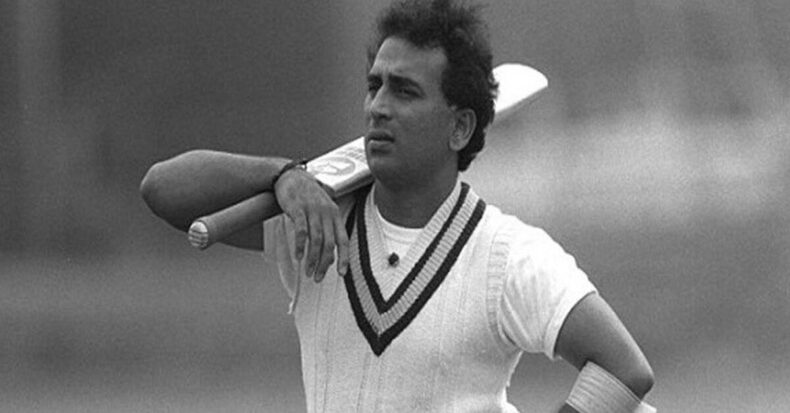Sunil Gavaskar is not only among the best of his generation but also among the best batsmen to have ever played the game thanks to his 13 centuries against the West Indies. Remember that Gavaskar scored all of his runs as an opener against fast bowlers who were at the top of their game? In domestic cricket, Sunil Gavaskar had never encountered such fast bowling.
Today is the birthday of former Indian captain and great batsman Sunil Gavaskar. Gavaskar, popularly known as’ Little Master’, has made many records in his name and has brought laurels to Bharata. In the 70s and 80s, West Indies bowlers were creating fear in the hearts of all the batsmen of the world with their fastballs. Then Little Master started making one record after another.
he told the world that he was an upcoming superstar. In his first series, this dashing batsman had scored 774 runs. During this period, he had scored one double century, four centuries, and three half-centuries. No batsman has been able to break his record even today.
The song, which was written in the West Indies for Gavaskar, popularly known as “Little Master”, was written by Lord Realtor in the 70s. His lyrics were like, “It was Gavaskar, the real master, just like a wall.”

This song later became so famous that it was often played in matches between India and the West Indies. Gavaskar never used to let any bowler dominate himself. He was of small stature, but every bowler used to think a little before bowling in front of him and used to make a different strategy. If he had settled at the crease, he would have put any bowler in trouble.
Talking about Gavaskar’s career, he played 125 matches in Tests and scored a total of 10122 runs. Apart from this, in ODIs, he scored a total of 3092 runs in 108 matches at an average of over 35, including a century and 27 half-centuries. He scored runs in Tests at an average of more than 51 and scored 34 centuries and 45 half-centuries. Representing Mumbai in domestic cricket, this legend has a total of 25834 runs in 348 first-class matches, in which his highest score is 340 runs. He scored 81 centuries and 105 half-centuries in first-class cricket. Sunil Gavaskar was the first player to score a thousand in Test cricket. He achieved this in his last series against Pakistan in 1987. He has scored a total of 10,122 test runs in his career. His record was broken in 1993 by Australian legend Allan Border.
The unusual record
Cricket’s first World Cup started on June 7, 1975. In the very first match, there was a match between the India and England teams. During that time, there were matches of 60 overs, not 50 overs. batting first in that match between India and England, England’s team scored the highest 334 runs of that period. Sunil Gavaskar and Eknath Solkar entered the field to open the Indian innings. Both were under pressure to complete England’s impossible target of 334 runs. Looking at the big target at that time, there was a need to score runs at a fast pace.
Gavaskar got into the same defensive mood as his Test cricket innings and started batting accordingly. Gavaskar remained not out till the end, but he faced a total of 174 balls and scored 36 runs. The Indian team lost the match by 202 runs to the England team in the very first match.

This innings of Gavaskar was criticized a lot in the cricket world. English cricketer Dennis Compton called it a very negative attitude towards the game. Even today this innings is counted among the slowest innings of world cricket. Playing 174 balls, Gavaskar hit just one boundary in his, not out innings of 36 runs.
The greatness of Gavaskar
One of the most anticipated test series between India and Pakistan occurred during the 1987 Pakistan cricket visit to India. After the first four test matches finished in draws, it was widely anticipated that the fifth would also be a draw when the teams arrived at Bangalore’s M Chinnaswamy Stadium. The first side to bat was Pakistan, which was bowled out for 116. It turned out that the Chinnaswamy wicket was a terrible turner. Maninder Singh made a record-breaking 7 for 27 by spinning the ball.He dismissed the Pakistani batting order in just 19 overs.
Iqbal Qasim and Tauseef Ahmed, the two Pakistani spinners, entered the game when India batted. With the help of keeper Saleem Yousuf, Ramiz Raja, and captain Imran Khan, Pakistan batted better in its second innings. India now had to chase 220 runs, and Sunil Gavaskar was tasked with giving India a strong start.
One of the greatest opening batsmen of all time, Sunil “Sunny” Gavaskar, demonstrated his brilliance in the fifth test match.
The Chinnaswamy Stadium’s wicket had become unplayable by the time Sunil began his second innings. The ball was being squarely turned by Pakistani spinners Tauseef Ahmed and Iqbal Qasim. The wicket had tons of bounce, which made things worse. Gavaskar was forced to leave one of Tauseef’s deliveries because it climbed so high that it looked like a bouncer from a fast bowler. On another occasion, Gavaskar played a flawless on-drive, but when he completed, the onlookers only saw a flurry of dust near the wicket.
Perhaps no other batsman in the world could have played that stroke better on an unfavorable surface, said the renowned Pakistani analyst Chishty Mujahid. By that point, every delivery had turned into a potential wicket-taking ball, but Gavaskar was exempt.

Every third ball was taking the edge or striking the glove, so Imran Khan ordered all of his fielders to close in. Sunil Gavaskar, though, was cover driving the ball as if the pitch were a batting haven. Gavaskar blasted a direct shot to a ball that had been put outside the off stump, shocking the cunning Iqbal Qasim.
Sunil played the ball late behind the bowler after waiting for it to complete its whole path; it was a four. Gavaskar was the target of every ploy Imran Khan employed. The legendary Wasim Akram returned, but the Indian batsman seemed unconcerned. Not that Sunny was unaffected by the challenging wicket. The wicket was turning so much, according to legendary Hindi commentator Sushil Doshi, that even the great Gavaskar was mistiming his shots. Though he persisted as only he could, English pundit Anupam Gulati concluded that Gavaskar had succeeded in putting the entire Pakistani squad under strain.
Apart from his great brother-in-law GR Vishwanath and fellow Mumbai batsman Dilip Vengsarkar, Gavaskar was aware that he could not depend on the Indian lower middle order to consistently post high totals. He became a cautious batsman as a result. Malcolm Marshall and Michael Holding discovered that he had the potential to be a lethal batsman when needed in Delhi’s Feroz Shah Kotla stadium during the second test of the 1983 West Indies tour of India. Gavaskar scored 121 runs with two sixes and 15 fours, or approximately one run per ball.
Australia had Dennis Lillee and Jeff Thompson during his time. England had John Emburey, Bob Willis, and Ian Botham. The Richard Hadlee of New Zealand. Imran Khan, Sarfaraz Nawaz, Abdul Qadir, and a young Wasim Akram were prominent figures in Pakistan. The most terrifying fast bowlers in the history of the sport made up the West Indies pace attack. Gavaskar had to contend with Michael Holding’s incredible speed, Joel Garner’s pinpoint accuracy, Andy Roberts’ talent, and Malcolm Marshall’s agility. Sunil Gavaskar is not only among the best of his generation but also among the best batsmen to have ever played the game thanks to his 13 centuries against the West Indies.
Remember that Gavaskar scored all of his runs as an opener against fast bowlers who are at the top of their game? In domestic cricket, Sunil Gavaskar had never encountered such fast bowling.












